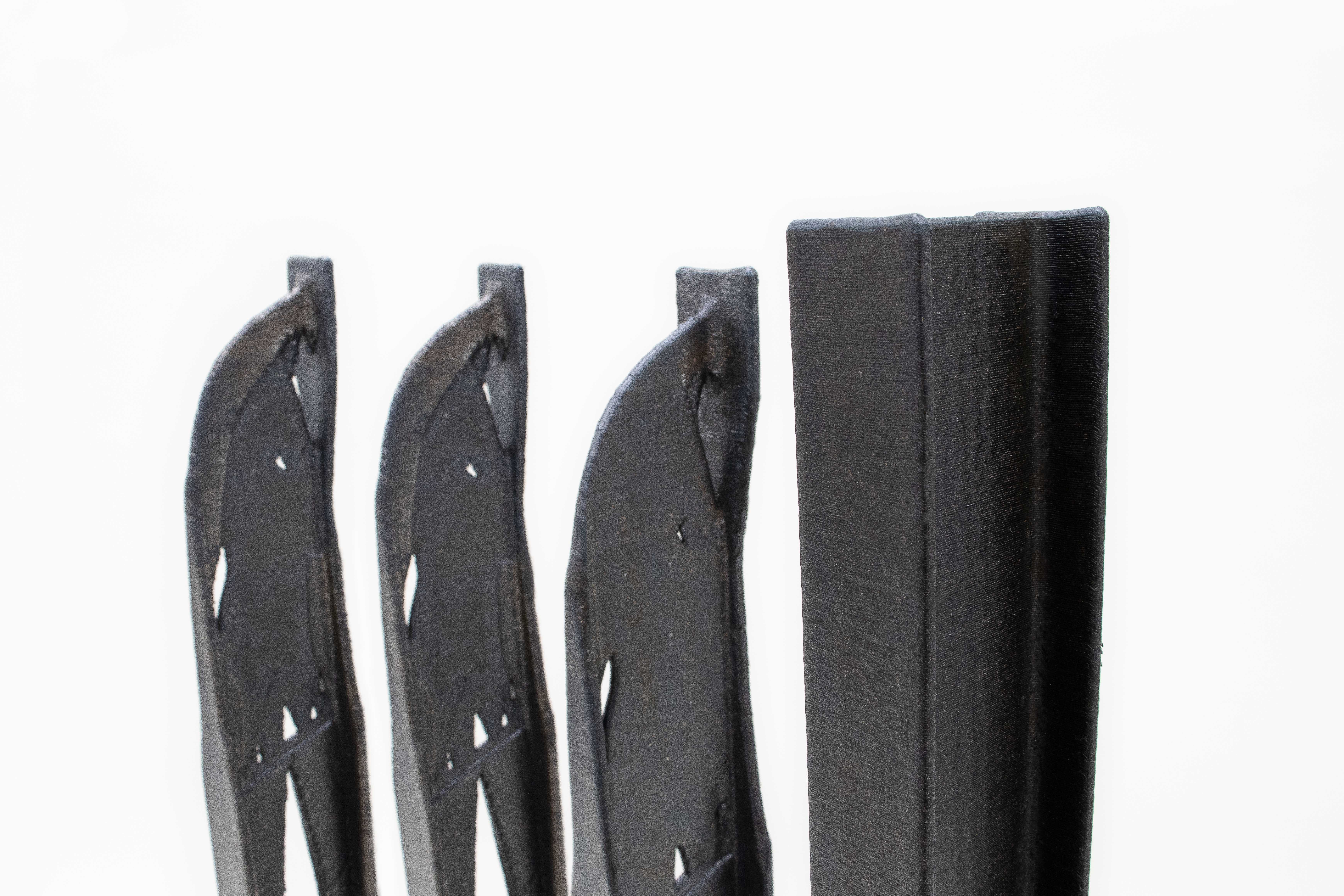The use of wire feedstock with a laser energy source in DED has gained momentum in recent years, with increasing research and industrial applications. These features make it a new and promising option in the field of additive manufacturing, generating significant interest and exploration across various industries.
As this technology continues to evolve, more industries are exploring its potential benefits and innovative uses.
DED vs. other additive manufacturing processes
The main difference between Directed Energy Deposition (DED) and other additive manufacturing processes lies in the way the material is deposited and the overall approach to building parts or components.
- Deposition Method: In DED, a focused energy source, such as a laser or electron beam, is used to melt and fuse metallic material as it is precisely deposited layer by layer. This allows for the creation of complex geometries and the addition of material to existing structures.
- Feedstock: DED typically uses wire feedstock as the material, in contrast with other processes such as PBF that use metallic powder as the raw material.
- Applications: DED is well-suited for repairing components, adding material to worn-out parts, and building medium to large-scale, complex structures, such as industrial machinery or aerospace components.
Other metallic additive manufacturing processes, such as Selective Laser Melting (SLM) and Electron Beam Melting (EBM), fall under the category of Powder Bed Fusion (PBF) techniques. In PBF, a thin layer of metallic powder is spread over the build platform, and a laser or electron beam selectively melts the powder to create the desired shape one layer at a time. The process is repeated for each layer until the final part is complete.
DED: Integrated Energy Source and Feedstock Deposition
In Directed Energy Deposition (DED), both the energy source and the feedstock come together during the manufacturing process, enabling a continuous build process.
The energy source is precisely directed to the point where the material is being deposited and the feedstock is continuously fed into the system while being melted. As the feedstock material is fused, it adheres to the previously deposited layers, creating a cohesive structure.
This simultaneous combination of the energy source and feedstock in DED distinguishes it from other metallic additive manufacturing processes like Powder Bed Fusion (PBF) techniques, where the metallic powder is spread over the build platform separately from the energy source, and the powder is selectively melted to create the part.
PBF processes often require stopping the build process to spread a new layer of powder, which can lead to potential downtime and decreased productivity.
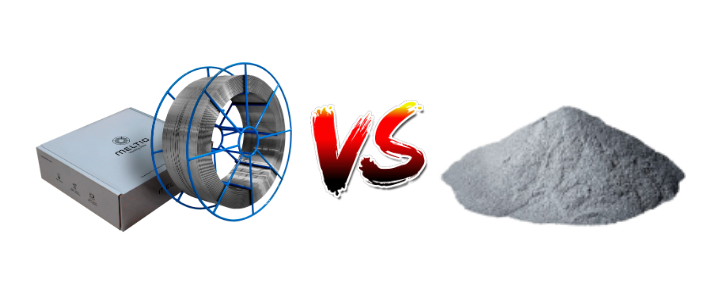
Wire + Laser = A new DED combination
The combination of using wire as feedstock and a laser as the energy source in DED is considered a new combination in the context of additive manufacturing due to its unique advantages and recent advancements in technology.
While DED itself has been in use for several years, the specific use of wire feedstock with a laser energy source is a relatively recent development and has gained increasing attention in various industries.
Here are some reasons why this combination is considered new and noteworthy:
- Material Versatility: The use of wire feedstock offers a wider range of material options compared to other DED feedstock options, such as powder. This grants the deposition of a broader variety of alloys, making it well-suited for a diverse range of applications across different industries.
- Continuous Deposition: The continuous feed of wire feedstock during the DED process allows for a seamless and uninterrupted additive build, resulting in increased efficiency and reduced production time. This continuous deposition also eliminates the need for frequent interruptions and manual handling, further streamlining the process.
- Large-Scale Applications: This combination is particularly well-suited for producing large-scale components due to the continuous feed and reduced need for support structures. It allows for the creation of sizable parts with reduced production time and cost-effectiveness.
Benefits of a Wire-Based 3D Printing Process
As an innovative approach to additive manufacturing, wire-based 3D printing offers a range of benefits that set it apart from traditional powdered feedstock methods. Here are some of the advantages:
- Material Waste Reduction: Wire-based additive manufacturing processes often result in lower material waste compared to other methods that use powdered feedstock. Since the wire is consumed only as needed, there is minimal excess material, leading to cost savings and a more sustainable approach.
- Cost-Effectiveness: Wire feedstock usually is more cost-effective than powdered alternatives. The production and handling of wire are generally more straightforward and economical, contributing to overall lower material costs. Wire feedstock, readily available as a welding commodity, proves to be significantly more cost-effective than powders. With wire prices starting at approximately $3.00 per pound, compared to the often expensive powders, cost savings of up to 10 times can be achieved. This cost disparity can be particularly pronounced in certain alloys.
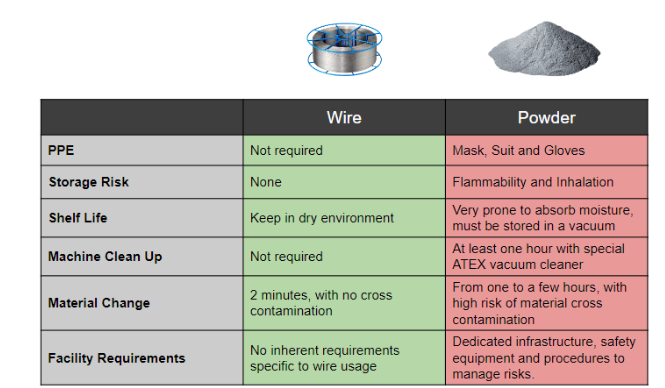
- Enhanced Productivity: It can be more efficient and productive, especially in continuous deposition systems. The continuous feed of wire allows for uninterrupted production, minimizing downtime and maximizing output.
- Reduced Need for Protective Equipment: Unlike some powdered additive manufacturing processes, wire-based methods do not involve the risk of aerial particulates. As a result, there may be reduced need for extensive protective equipment, leading to improved operator comfort and safety.
- Facility Requirements: Wire-based additive manufacturing processes present the advantages of facilities with limited space or specific infrastructure constraints. The simpler handling of wire feedstock requires fewer facility modifications.
- Convenient Storage: Wire feedstock is easier to store compared to bulkier and more cumbersome powdered materials. Wire feedstock typically requires less storage space allowing a better organization and utilization of storage areas, maximizing the available space.
- Inventory Management: The structured form of wire feedstock allows for easier inventory management and control. It is simpler to track the quantity of wire remaining, enabling better planning for material restocking. Moreover, wire feedstock tends to have a longer shelf life compared to some powdered materials, which may ensure the material remains usable over extended periods without degradation.
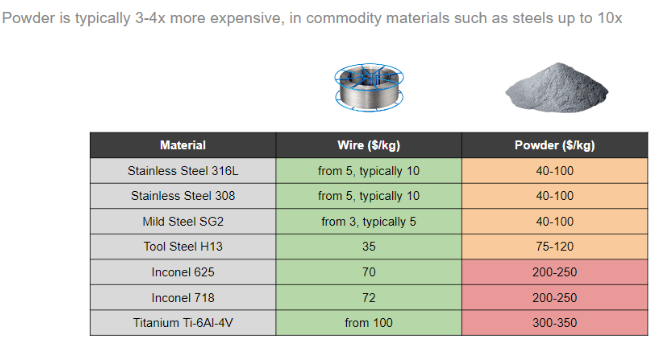
- Reduced Contamination Risk: Since the wire is solid and less prone to dispersal, the risk of cross-contamination between different materials is minimized. In contrast, powdered feedstock can be more susceptible to mixing or accidental spills, leading to potential material contamination.
- Improved Handling and Transportation: Wire feedstock is easier to handle and transport due to its solid and structured nature. Usually, it is commercialized on spools or reels, making it convenient to load into the 3D printing system.
- Simplified Machine Clean-Up: Wire-based additive manufacturing processes require less machine clean-up compared to powdered feedstock methods, as there is less residual material to remove after printing. This results in cleaner and tidier workspaces. There is less residue or dust, minimizing the need for frequent cleanups and contributing to a more efficient workflow.
- Material Change: Switching between different materials is often more straightforward with wire-based additive manufacturing. The ability to swap wire types with relative ease can support the production of diverse components without significant downtime and also allow the printing of dual material parts.
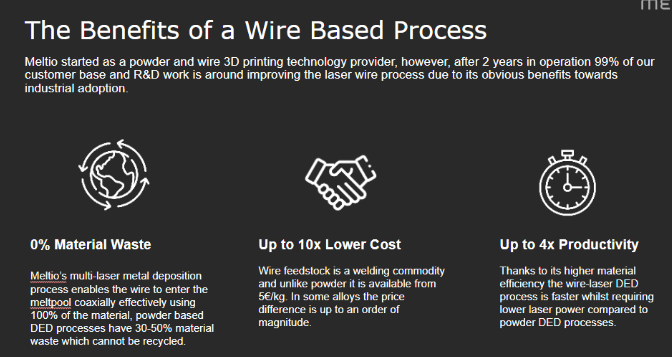
Additional Advantages of Meltio’s Wire-LMD
- Zero Material Waste: Meltio’s dual wire metal deposition process enables the wire to enter the melt pool coaxially, effectively using 100% of the material. In comparison, powder-based processes often generate significant material waste, ranging from 30% to 50%.
- Enhanced Microstructure: Meltio’s laser process produces an extremely compact heat-affected zone (HAZ), minimizing heat transfer to the layers below or the surrounding area of the melt pool. This results in a better microstructure of the printed part.
- Controlled Process: Meltio’s LMD ensures precise control over the wire as it enters the melt pool coaxially. The wire melts at the point of contact with the substrate, independent of the material flow. This allows for the implementation of a sophisticated feedback system, ensuring a stable and controlled process.
- Meltio’s Deposition Head: The design features a coaxial wire feed, ensuring that the wire comes through the center of the melt pool. This setup enables consistent printing quality in all directions. Additionally, the system incorporates a distributed laser system with six 200W lasers positioned around its diameters. This arrangement ensures an extended service life, thanks to the low optical densities of the lasers.
- Dual Wire Capability: Meltio’s printhead is equipped with two independent wire feeders, enabling the printing of two different materials during a single print. This capability allows for applications such as hard-facing or anti-corrosion coatings and it offers an easy, fast, convenient, and sustainable solution for dual 3D printing without the risk of cross-contamination.
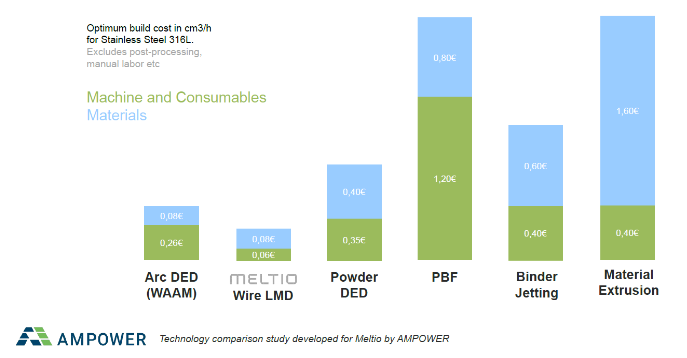
Conclusion
- Meltio is taking wire all the benefits from the wire feedstock with the benefits of the laser as an energy source: Discover the Applications.
- Coaxial head design with low power lasers.
- Dual wire capability.


